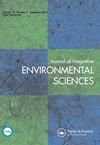The influence of climate change on tsunami-like solitary wave inundation over fringing reefs
IF 3.5
4区 环境科学与生态学
Q3 ENVIRONMENTAL SCIENCES
Journal of Integrative Environmental Sciences
Pub Date : 2019-01-01
DOI:10.1080/1943815X.2019.1614071
引用次数: 17
Abstract
ABSTRACT The protective capability of fringing reefs against tsunami hazards has been reported in numerous post-disaster surveys. It is believed that global warming is changing the water level over the reef flat and reef surface roughness by sea-level rise and coral bleaching. For a better understanding of the influence of climate change on tsunami hazards over fringing reefs, this study utilized a shock-capturing Boussinesq wave model, FUNWAVE-TVD, to simulate the tsunami-like solitary wave propagation and run-up over fringing reefs. Calibrated and validated by the newly obtained experimental data, the present model with shock-capturing scheme, in which only the ratio of wave height to water depth is used to trigger wave breaking, shows reasonable prediction of solitary wave transformation and run-up height over sharply varying reef bathymetry. Numerical experiments were then carried out to investigate the effects of sea-level rise and degrading of the reef surface roughness on the solitary wave inundation distance and fluid force distribution in the inundation zone. Numerical results clearly demonstrate how tsunami hazards change within the inundation zone in response to higher water levels and lower reef roughness and suggest climate change, especially sea-level rise, will significantly increase tsunami hazards in the low-lying areas of the reef-lined coasts. Presented results are discussed for the effects of sea-level rise and coral bleaching on the solitary wave process and implications to further improve the resilience under the threat of climate change.气候变化对海啸样孤立波淹没边缘珊瑚礁的影响
在许多灾后调查中,已经报道了边缘珊瑚礁对海啸灾害的保护能力。人们认为,全球变暖导致海平面上升和珊瑚白化,改变了礁滩的水位和礁面粗糙度。为了更好地了解气候变化对海啸对珊瑚礁危害的影响,本研究利用冲击波捕获Boussinesq波模型FUNWAVE-TVD模拟海啸样孤立波在珊瑚礁上的传播和上升。通过对新获得的实验数据进行校正和验证,该模型中仅使用波高与水深的比值来触发破波,可以合理地预测急剧变化的礁体水深下的孤立波变换和爬升高度。通过数值实验研究了海平面上升和礁面粗糙度的降低对淹没区内孤立波淹没距离和流体力分布的影响。数值结果清楚地表明,随着水位的升高和珊瑚礁粗糙度的降低,淹没区内的海啸灾害是如何变化的,并表明气候变化,特别是海平面上升,将显著增加礁滨海岸低洼地区的海啸灾害。讨论了海平面上升和珊瑚白化对孤立波过程的影响,以及进一步提高气候变化威胁下的适应能力的意义。
本文章由计算机程序翻译,如有差异,请以英文原文为准。
求助全文
约1分钟内获得全文
求助全文
来源期刊

Journal of Integrative Environmental Sciences
ENVIRONMENTAL SCIENCES-
CiteScore
3.90
自引率
0.00%
发文量
13
审稿时长
>12 weeks
期刊介绍:
Journal of Integrative Environmental Sciences (JIES) provides a stimulating, informative and critical forum for intellectual debate on significant environmental issues. It brings together perspectives from a wide range of disciplines and methodologies in both the social and natural sciences in an effort to develop integrative knowledge about the processes responsible for environmental change. The Journal is especially concerned with the relationships between science, society and policy and one of its key aims is to advance understanding of the theory and practice of sustainable development.
 求助内容:
求助内容: 应助结果提醒方式:
应助结果提醒方式:


